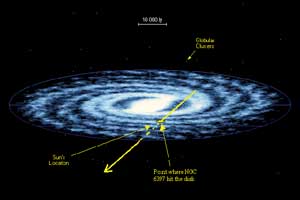Observational evidence provides new theory on the formation of stars
By Steve KoppesNews Office
 Twenty thousand light years across, this perspective of the Milky Way galaxy is a view from above. The areas highlighted in the boxed section of the image show where NGC 6231 formed at about the same time NGC 6397 had passed through the Milky Way nearly five million years ago, providing new evidence about star formation.  This image shows the Milky Way galaxy as it would appear from the outside. The bold yellow arrow shows the direction of motion of NGC 6397 (the distance traveled by NGC 6397 in the last five million years is much less than this; the size of motion has been exaggerated for clarity.) |
Astronomical observations more than a century in the making show that an old cluster of stars called NGC 6397 plowed through the galactic plane of the Milky Way five million years ago, apparently leaving in its wake an entirely new star cluster, NGC 6231. This scenario, reconstructed by a Chicago alumnus and his former professor, marks the first observational evidence that groups of stars called globular clusters can trigger the formation of new stars.
Richard Rees (Ph.D.,’95), an assistant professor of physical science at Westfield State College in Massachusetts, presented the finding Monday, Jan. 5, at the American Astronomical Society meeting in Atlanta. His co-author was Kyle Cudworth, Professor in Astronomy & Astrophysics and Director of the Yerkes Observatory.
The stars in globular clusters roam the Milky Way in a halo around the galaxy’s flattened disk, unlike the sun and most other stars.
“Since NGC 6397 is about 250,000 times the mass of the sun, it seemed reasonable that it may have had a noticeable effect on the Milk Way’s disk at the point of impact,” Rees said. And, as NGC 6397 is one of the globular clusters closest to the Earth (approximately 7,500 light years away), it was possible to explore its motions in best detail, Cudworth said.
Rees and Cudworth were able to extrapolate the trajectory of NGC 6397 by combining two different measurements. They determined how fast the cluster was moving perpendicular to their line of sight by comparing the small changes in the position of its stars, as indicated by photographs taken of the cluster between 1893 and 1990 with telescopes in South Africa, Peru and Chile.
They used other astronomers’ determinations of the cluster’s velocity along their line of sight by using the Doppler effect, the shift in the color of light emitted from an object moving toward or away from Earth.
Combining the two measurements gave Rees and Cudworth the cluster’s movement in three-dimensions. Then, taking into account the galaxy’s rate of rotation, they examined the region where the cluster likely came into contact with the galactic disk.
“When I looked at a map of that region of the sky, NGC 6231 jumped out at me. I’m surprised we found something that easily,” Rees said.
The astronomers were able to estimate the youthfulness of the stars in NGC 6231, the new cluster, by their color and bright-ness, which according to theoretical calculations differ from those of older stars.
Astronomers believe that a variety of phenomena can form stars by compressing giant clouds of interstellar gas, leading to gravitational collapse. Possible causes of this compression include exploding stars, stellar winds from luminous stars, collisions between clouds, collisions between galaxies, and, as indicated in the new study, by globular clusters.
The study confirms a prediction about globular clusters made by George Mason University’s John Wallin and his collaborators in 1996. Wallin’s team predicted in the Astrophysical Journal that the gravitational field of a globular cluster plunging through a galaxy’s disk could sufficiently compress a gas cloud to trigger star formation.
Rees and Cudworth were unaware of the Wallin team’s prediction when they conducted their study. “It was just a ‘what’s there?’ kind of thing,” Cudworth said. “Once in awhile these things pay off nicely.”
Cudworth said he doubts that astronomers now have discov-ered a complete set of star-formation mechanisms.
“Fairly dense gas clouds that are just about ready to form stars are fairly common. What tips them over the edge to start contracting to form stars?” Cudworth asked.
“I would guess that stars may have found some ways that we haven’t thought of yet.”
Rees and Cudworth plan to do more similar follow-up studies of other globular clusters. “We’re guessing that there won’t be many more cases that will be as clean as this one,” Cudworth said. Far more time has elapsed since those clusters passed through the galactic disk, making it much harder to calculate where they have been.
![[Chronicle]](/images/sidebar_header_oct06.gif)